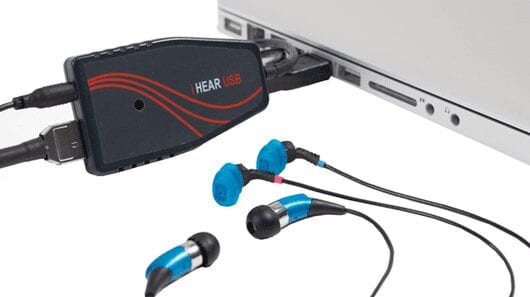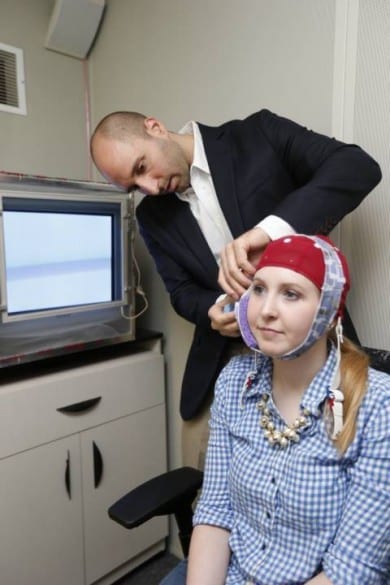
iHear, an invisible hearing aid, is designed to significantly lower the cost of personalized hearing devices
According to the Hearing Loss Association of America, 48 million Americans (around 20 percent of the population) report some degree of hearing loss. This problem is compounded by the costs associated with having the condition diagnosed and a hearing aid fitted in a clinic, causing many to allow the ailment to go untreated. iHear, an invisible hearing aid, is designed to significantly lower the cost of personalized hearing devices by enabling the user to test the extent of their condition and calibrate the hearing aid from their own home.
iHear is the brainchild of Adnand Shennib, who identified a gap between cheap hearing aids with general, preset configurations, and prescribed hearing aids that can cost thousands of dollars. Shennib, a biomedical engineer who has been developing advanced hearing devices in Silicon Valley for more than 20 years, set about developing a high-quality hearing aid that was low in cost, but could also be customized to suit the user’s condition.
The iHear system is made up of a test kit, a miniaturized hearing device around the size of a kidney bean that fits inside the ear canal, a USB device and an online platform.
The first step is for the user to test the degree of their hearing loss using the iHear test kit. This involves plugging the USB device into their computer and a pair of specially-designed headphones into their ears. An online diagnostics tool then allows them to determine the extent of their hearing loss.
Once the test is completed, the hearing device itself is shipped to the user. From here, the user can complete the fitting process themselves, program settings for different environments, and adjust the hearing device at any time.
Included is a tool kit, a small triangular device that allows remote control of iHear when it is being worn, while also doubling as a place for storage when it is not.
According to the company, having an online platform whereby the user can conduct their own hearing test and electronically calibrate the device themselves is primarily where the costs are reduced. Though this could provide viable solutions for sufferers of hearing loss conditions described as flat, reverse slopes, high frequency, mild, and moderate to moderately severe, the company emphasizes it is not suitable for severe or profound hearing loss.
The Latest on: Hearing Aid
[google_news title=”” keyword=”Hearing Aid” num_posts=”10″ blurb_length=”0″ show_thumb=”left”]
via Google News
The Latest on: Hearing Aid
- 'Honest mom' influencer Libby Ward gets hearing aids after 10 years of 'frustration and shame': 'It's a lot'on April 30, 2024 at 9:11 am
Canadian influencer Libby Ward gave her followers a glimpse into her personal life as she marked a self-care milestone — getting her first hearing aids. Ward, who has earned an audience on social ...
- The top UN court opens a hearing to deliver its decision in Nicaragua's request to order Germany to halt aid to Israelon April 30, 2024 at 6:18 am
The top UN court opens a hearing to deliver its decision in Nicaragua's request to order Germany to halt aid to Israel ...
- My daughter was born with profound hearing loss in one ear. We decided not to go through with a cochlear implant.on April 30, 2024 at 6:10 am
When her daughter was 3 months old, they found out she had profound hearing loss. They want her to decide whether she gets a cochlear implant.
- JLab Introduces 2-in-1 OTC Hearing Aid and Earbud for Under $100on April 30, 2024 at 1:57 am
San Diego, CA, April 30, 2024 (GLOBE NEWSWIRE) -- Today, the award-winning designer of personal tech, JLab, introduced the Hear OTC Hearing Aid, a sleek 2-in-1 solution that merges hearing aid ...
- What to Know About Jabra, Lexie, Sony, and Other Over-the-Counter Hearing Aid Brandson April 29, 2024 at 6:39 am
What support they offer, where you can buy them, how much they cost, and moreFrom left: Jabra, Lexie, and Eargo over-the-counter hearing aids.By Catherine RobertsOver-the-counter (OTC) hearing ...
- Chico Hearing Aid Center celebrates 75 years of enriching lives through improved hearingon April 27, 2024 at 5:00 pm
The Chico Hearing Aid Center, a local establishment that has been providing hearing aid services to the community for 75 years, celebrated its anniversary on Sa ...
- New AirPods Point to a Hearing Aid Mode, Even More Health Trackingon April 27, 2024 at 5:00 am
I take a look at all the rumors about the upcoming AirPods, including a potential hearing aid mode that may launch with iOS 18. In the future, maybe AirPods could integrate even more sensors such as ...
- How much do hearing aids cost?on April 26, 2024 at 9:59 am
When it comes to hearing aid prices, there are two groups to consider: prescription hearing aids and over-the-counter hearing aids (OTC). less than $1,000 and ...
- Does Medicare pay for hearing aids?on April 26, 2024 at 9:58 am
The average cost of hearing aids was around $4,600 as of 2018, but these days a pair of prescription-grade hearing aids can cost anywhere from $1,000 to more than $8,000 a pair. Over-the-counter or ...
- The best hearing aids you can buy onlineon April 26, 2024 at 9:58 am
At $397 per pair, this hearing aid is the epitome of quality OTC hearing aids you can buy online: cheap, effective, and with a light design that makes for true all-day comfort. Small, nearly invisible ...
via Bing News










